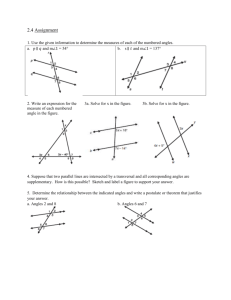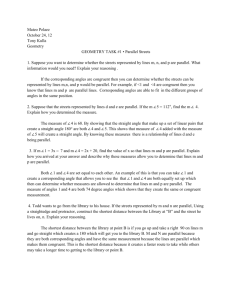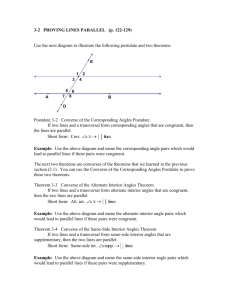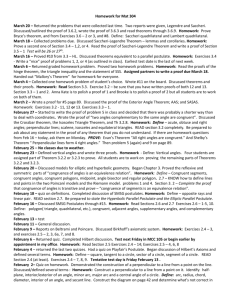Homework Mat 304 – Spring 2011 January 11 – Discussed: the
advertisement
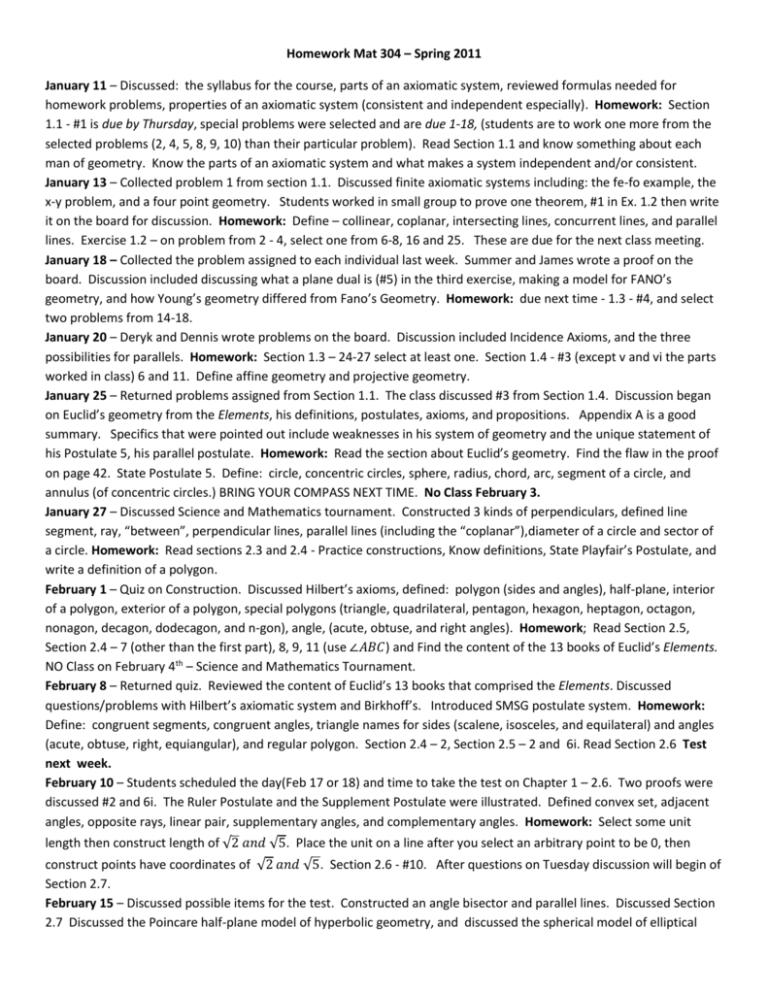
Homework Mat 304 – Spring 2011 January 11 – Discussed: the syllabus for the course, parts of an axiomatic system, reviewed formulas needed for homework problems, properties of an axiomatic system (consistent and independent especially). Homework: Section 1.1 - #1 is due by Thursday, special problems were selected and are due 1-18, (students are to work one more from the selected problems (2, 4, 5, 8, 9, 10) than their particular problem). Read Section 1.1 and know something about each man of geometry. Know the parts of an axiomatic system and what makes a system independent and/or consistent. January 13 – Collected problem 1 from section 1.1. Discussed finite axiomatic systems including: the fe-fo example, the x-y problem, and a four point geometry. Students worked in small group to prove one theorem, #1 in Ex. 1.2 then write it on the board for discussion. Homework: Define – collinear, coplanar, intersecting lines, concurrent lines, and parallel lines. Exercise 1.2 – on problem from 2 - 4, select one from 6-8, 16 and 25. These are due for the next class meeting. January 18 – Collected the problem assigned to each individual last week. Summer and James wrote a proof on the board. Discussion included discussing what a plane dual is (#5) in the third exercise, making a model for FANO’s geometry, and how Young’s geometry differed from Fano’s Geometry. Homework: due next time - 1.3 - #4, and select two problems from 14-18. January 20 – Deryk and Dennis wrote problems on the board. Discussion included Incidence Axioms, and the three possibilities for parallels. Homework: Section 1.3 – 24-27 select at least one. Section 1.4 - #3 (except v and vi the parts worked in class) 6 and 11. Define affine geometry and projective geometry. January 25 – Returned problems assigned from Section 1.1. The class discussed #3 from Section 1.4. Discussion began on Euclid’s geometry from the Elements, his definitions, postulates, axioms, and propositions. Appendix A is a good summary. Specifics that were pointed out include weaknesses in his system of geometry and the unique statement of his Postulate 5, his parallel postulate. Homework: Read the section about Euclid’s geometry. Find the flaw in the proof on page 42. State Postulate 5. Define: circle, concentric circles, sphere, radius, chord, arc, segment of a circle, and annulus (of concentric circles.) BRING YOUR COMPASS NEXT TIME. No Class February 3. January 27 – Discussed Science and Mathematics tournament. Constructed 3 kinds of perpendiculars, defined line segment, ray, “between”, perpendicular lines, parallel lines (including the “coplanar”),diameter of a circle and sector of a circle. Homework: Read sections 2.3 and 2.4 - Practice constructions, Know definitions, State Playfair’s Postulate, and write a definition of a polygon. February 1 – Quiz on Construction. Discussed Hilbert’s axioms, defined: polygon (sides and angles), half-plane, interior of a polygon, exterior of a polygon, special polygons (triangle, quadrilateral, pentagon, hexagon, heptagon, octagon, nonagon, decagon, dodecagon, and n-gon), angle, (acute, obtuse, and right angles). Homework; Read Section 2.5, Section 2.4 – 7 (other than the first part), 8, 9, 11 (use ∠𝐴𝐵𝐶) and Find the content of the 13 books of Euclid’s Elements. NO Class on February 4th – Science and Mathematics Tournament. February 8 – Returned quiz. Reviewed the content of Euclid’s 13 books that comprised the Elements. Discussed questions/problems with Hilbert’s axiomatic system and Birkhoff’s. Introduced SMSG postulate system. Homework: Define: congruent segments, congruent angles, triangle names for sides (scalene, isosceles, and equilateral) and angles (acute, obtuse, right, equiangular), and regular polygon. Section 2.4 – 2, Section 2.5 – 2 and 6i. Read Section 2.6 Test next week. February 10 – Students scheduled the day(Feb 17 or 18) and time to take the test on Chapter 1 – 2.6. Two proofs were discussed #2 and 6i. The Ruler Postulate and the Supplement Postulate were illustrated. Defined convex set, adjacent angles, opposite rays, linear pair, supplementary angles, and complementary angles. Homework: Select some unit length then construct length of √2 𝑎𝑛𝑑 √5. Place the unit on a line after you select an arbitrary point to be 0, then construct points have coordinates of √2 𝑎𝑛𝑑 √5. Section 2.6 - #10. After questions on Tuesday discussion will begin of Section 2.7. February 15 – Discussed possible items for the test. Constructed an angle bisector and parallel lines. Discussed Section 2.7 Discussed the Poincare half-plane model of hyperbolic geometry, and discussed the spherical model of elliptical geometry. Homework: 2.7 – State the Elliptical parallel Axiom and the Hyperbolic parallel axiom. Bisect an angle, construct a Euclidean parallel. Read Section 2.7, be able to describe a model for each non-Euclidean geometry . Problems 1 & 4 in the section. February 17 – Began the discussion of neutral geometry with emphasis on writing correct symbols (say what you mean). Defined – midpoint of a segment, congruent angles, congruent segments, congruent polygons, vertical angles, midpoint of a segment, bisector of an angle, median of a triangle, centroid of a triangle, altitude of a triangle, and orthocenter of a triangle. Homework: Section 3.2 - #4 part of the theorem - either segments of angles, define the words above, construct the medians and altitudes of three different kinds of triangles (scalene right, scalene obtuse, and scalene acute) and paraphrase Theorem 3.2.3 into four conditional statement. February 22 – Answered questions about orthocenter. Went to the lab and constructed the orthocenter and centroid with Geometer’s Sketchpad. Answered questions about paraphrase of Theorem 3.2.3. Discussed the proof of Paush’s “Axiom”, read the crossbar theorem, and discussed the proof of the isosceles triangle theorem. Students were reminded to read the text. Homework: Parts of theorem 3.2.3 and two more were assigned to specific students. Students were to prove their assigned part and one other of the six things to prove. Define: incenter and circumcenter. Students are to practice the construction of those two points. February 24 – Proved two theorems in class. Outlined the proofs of two more theorems. Quiz on constructions. Homework: READ THE CHAPTER THROUGH SECTION 3.2. READ POSTULATES OF SMSG 1-15. Prove: If two congruent angles form a linear pair, then the sides of one of the angles are perpendicular. (Deryk’s Theorem) Section 3.2 problem 9. Polish any proofs that you worked for today that need a rewrite. March 1 - Collected one proof from the last week of problems (not the ones that were discussed in detail on the board last time). Discussion included how to prove POLYGONS congruent: ASA, AAS,SASAS, and SSS. Proofs were read and discussed or partially written on the board. Demonstrated the construction “how to copy an angle”. Basic constructions that have been demonstrated to date include: construct perpendiculars (3 kinds), parallel to a line through a point not on the line, angle bisector, copy a segment, and copy an angle. Homework: Select and write a proof for 12 or 13 in section 3.2 , outline a proof for #1 in Section 3.3, and complete the handout on construction. Deryk, yours is outside my office. March 3 – Discussed theorems left in Section 3.3. Student drew for a problem to solve in pairs and write the proof on the board. Third one will come next class period. Homework: Three problems were assigned by pairs. . . 6, 7, and 10 from section 3.3. Students should attempt problems other than the one due from the pair. Test on Chapter 3 the week after spring break. March 8 – Collected the pairs proofs. Discussed Saccheri and Lambert quadrilaterals and theorems associated with them. Homework: Define Saccheri quadrilateral and Lambert quadrilateral. READ THE PROOF OF THE SACCHERILENGENDRE THEOREM AND TH. 3.6.6. Read the last few sections of the chapter again. Prove: Summer’s Theorem: “ If two angles are congruent and “ corresponding angles” (that are part of the larger angle) are congruent, remainding angles (that are part of the larger angle) are congruent. Brittany’s Theorem: All right angles are congruent. Kelsey’s Theorem: Perpendicular lines form four right angles. James’ Theorem: If point P is equidistant from two points, A and B, then P is on the perpendicular bisector of ̅̅̅̅ 𝐴𝐵. March 10 - Wrote two proofs during class (#9 and # 12). Then students wrote proofs from 3.6 in pairs. Homework: ̅̅̅̅ ≅ ̅̅̅̅ Dennis’ Theorem: If A-B-C , X-Y-Z, ̅̅̅̅ 𝐴𝐶 ≅ ̅̅̅̅ 𝑋𝑍, 𝑎𝑛𝑑𝐴𝐵 𝑋𝑌 then ̅̅̅̅ 𝐵𝐶 ≅ ̅̅̅̅ 𝑌𝑍. Section 3.6 - 11 and 15. Test week after spring break. March 22 – Two students wrote proofs on the board and they were critiqued. Class discussion was about the test this week and chapter 4 – Euclidean Geometry - defined terms. Homework: Define – trapezoid, isosceles trapezoid, rhombus, parallelogram, rectangle, square. March 24 – Continued in Chapter 4 – Outlined a synthetic proof of “opposite sides of a parallelogram are congruent” and then wrote an analytic proof. Discussed placement of shapes on a grid to best use the properties of the grid. Homework: Section 4.2 - #2 , #6 by synthetic methods and #9 by analytic methods.



